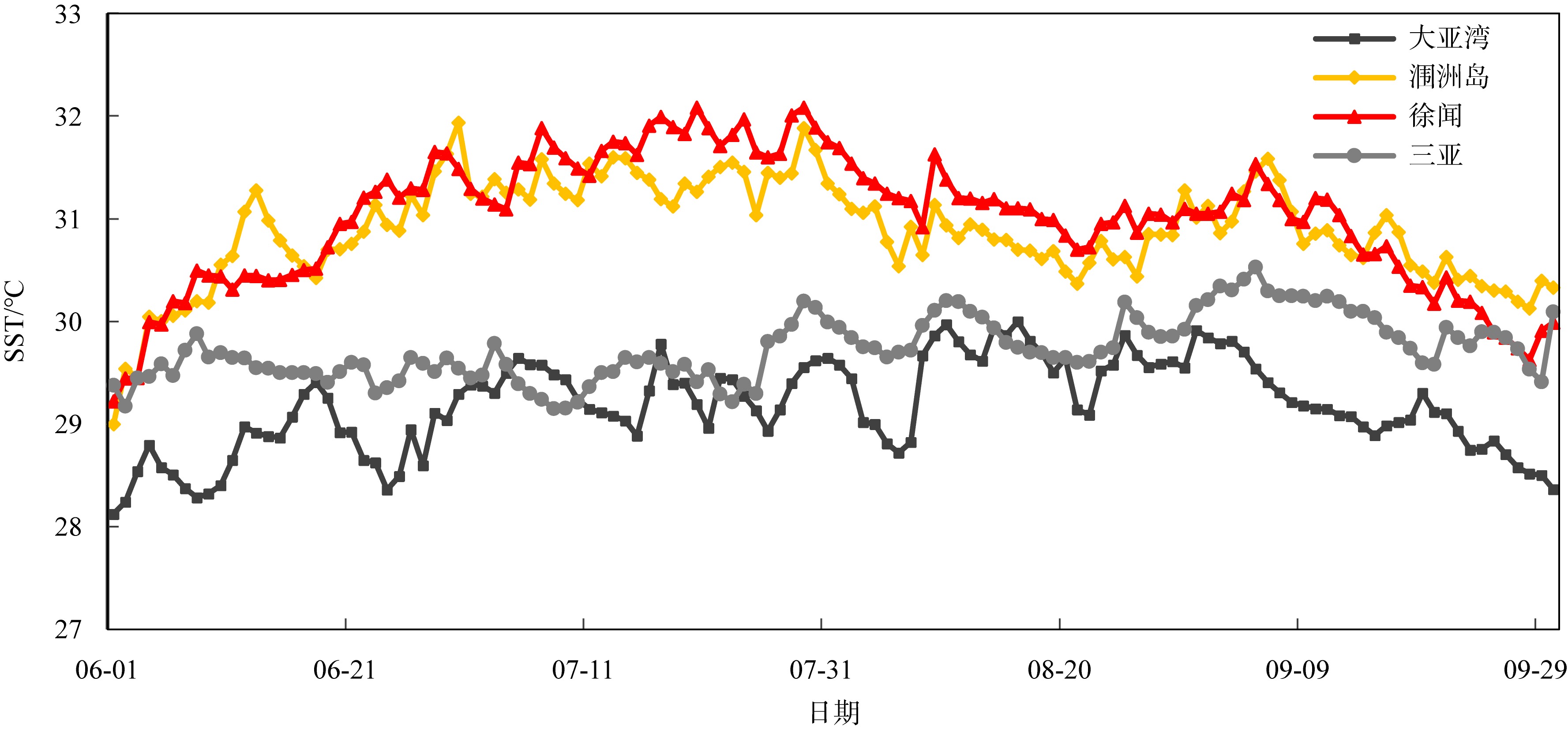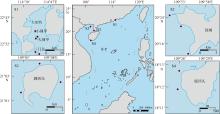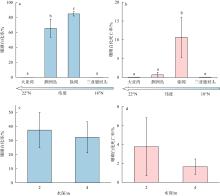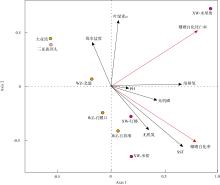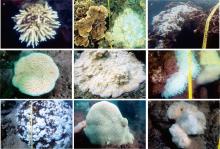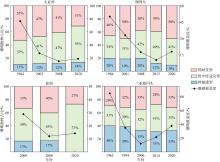热带海洋学报 ›› 2024, Vol. 43 ›› Issue (3): 58-71.doi: 10.11978/2023118CSTR: 32234.14.2023118
南海北部珊瑚群落结构特征及其对海洋热浪事件的响应
许莉佳1( ), 廖芝衡2, 陈辉3, 王永智1(
), 廖芝衡2, 陈辉3, 王永智1( ), 黄柏强1, 林巧云1, 甘健锋1, 杨静1
), 黄柏强1, 林巧云1, 甘健锋1, 杨静1
- 1.生态环境部华南环境科学研究所, 广东 广州 510535
2.北部湾环境演变与资源利用教育部重点实验室(南宁师范大学), 广西 南宁 530001
3.广东省环境科学研究院, 广东 广州 510045
-
收稿日期:2023-08-13修回日期:2023-10-20出版日期:2024-05-10发布日期:2024-06-04 -
作者简介:许莉佳(1987—), 女, 高级工程师, 主要从事珊瑚礁生态与环境保护研究。email: xulijia@scies.org
-
基金资助:国家自然科学基金项目(42277362); 国家自然科学基金项目(41806139); 广州市科技计划项目(202002030345); 中央级公益性科研院所基本科研业务专项(PM-zx703-202105-176); 中央级公益性科研院所基本科研业务专项(PM-zx703-202004-143)
Community structure of scleractinian corals in the northern South China Sea and their responses to the marine heatwaves
XU Lijia1( ), LIAO Zhiheng2, CHEN Hui3, WANG Yongzhi1(
), LIAO Zhiheng2, CHEN Hui3, WANG Yongzhi1( ), HUANG Baiqiang1, LIN Qiaoyun1, GAN Jianfeng1, YANG Jing1
), HUANG Baiqiang1, LIN Qiaoyun1, GAN Jianfeng1, YANG Jing1
- 1. South China Institute of Environmental Sciences, Ministry of Ecology and Environment, Guangzhou 510535, China
2. Key Laboratory of Environment Change and Resources Use in Beibu Gulf (Nanning Normal University), Ministry of Education, Nanning 530001, China
3. Guangdong Provincial Academy of Environmental Science, Guangzhou 510045, China
-
Received:2023-08-13Revised:2023-10-20Online:2024-05-10Published:2024-06-04 -
Supported by:National Natural Science Foundation of China(42277362); National Natural Science Foundation of China(41806139); Science and Technology Planning Project of Guangzhou City(202002030345); Central Public-Interest Scientific Institution Basal Research Fund(PM-zx703-202105-176); Central Public-Interest Scientific Institution Basal Research Fund(PM-zx703-202004-143)
摘要:
全球变暖背景下, 造礁石珊瑚大规模白化的频度和强度日益加大, 其生存也面临严峻的危机。南海北部海域被认为是气候变暖背景下我国造礁石珊瑚生存的避难所。综合分析该海域珊瑚群落的空间格局、历史演变及其对夏季高温的响应, 有利于深入认识我国造礁石珊瑚的适应性及相应的保护与养护。本研究于2020年夏季对大亚湾、涠洲岛、徐闻和三亚鹿回头的珊瑚礁/珊瑚群落开展了较为全面的生态调查, 并追踪了2020年海洋热浪的效应。结果显示, 珊瑚群落的优势种组成、物种数量和α多样性指数呈现明显的区域差异, 活珊瑚覆盖度在三亚鹿回头和大亚湾相对更高(分别为37.78%和17.97%); 珊瑚白化率和白化死亡率在徐闻海域最高(84.78%和10.68%), 其次是涠洲岛海域(65.52%和0.70%), 大亚湾和三亚鹿回头海域均未监测到珊瑚白化。结合历史数据分析表明, 南海北部海域珊瑚群落的活珊瑚覆盖度自1980年代以来发生大幅度下降, 但近年来趋于稳定并呈现出恢复的态势; 珊瑚群落结构演变上整体呈现出热耐受型物种和热中度适应型物种占比增加(大亚湾除外)的趋势。总体而言, 目前南海北部海域的珊瑚群落对海洋热浪具有一定的抵抗能力, 加强珊瑚礁区的保护和管理对于促进珊瑚群落的恢复和热敏感珊瑚物种避难所潜力的发挥至关重要。
引用本文
许莉佳, 廖芝衡, 陈辉, 王永智, 黄柏强, 林巧云, 甘健锋, 杨静. 南海北部珊瑚群落结构特征及其对海洋热浪事件的响应[J]. 热带海洋学报, 2024, 43(3): 58-71.
XU Lijia, LIAO Zhiheng, CHEN Hui, WANG Yongzhi, HUANG Baiqiang, LIN Qiaoyun, GAN Jianfeng, YANG Jing. Community structure of scleractinian corals in the northern South China Sea and their responses to the marine heatwaves[J]. Journal of Tropical Oceanography, 2024, 43(3): 58-71.
附表1
南海北部沿岸海域造礁石珊瑚种类(2020年)"
| 类群 | 科 | 属 | 物种 | 珊瑚礁区 | 耐热性类型 | |||
|---|---|---|---|---|---|---|---|---|
| 大亚湾 | 涠洲岛 | 徐闻 | 鹿回头 | |||||
| 复 杂 类 群 | 鹿角珊瑚科 Acroporidae | 鹿角珊瑚属 Acropora | 粗野鹿角珊瑚Acropora humilis | + | + | 热敏感型 | ||
| 风信子鹿角珊瑚 Acropora hyacinthus | + | 热敏感型 | ||||||
| 彰显鹿角珊瑚Acropora insignis | + | 热敏感型 | ||||||
| 美丽鹿角珊瑚Acropora muricata | + | 热敏感型 | ||||||
| 多孔鹿角珊瑚Acropora millepora | + | 热敏感型 | ||||||
| 霜鹿角珊瑚Acropora pruinosa | + | + | 热敏感型 | |||||
| 单独鹿角珊瑚Acropora solitaryensis | + | 热敏感型 | ||||||
| 柔枝鹿角珊瑚Acropora tenuis | + | 热敏感型 | ||||||
| 强壮鹿角珊瑚Acropora valida | + | 热敏感型 | ||||||
| 蔷薇珊瑚属 Montipora | 繁锦蔷薇珊瑚 Montipora efflorescens | + | + | 热敏感型 | ||||
| 贺氏蔷薇珊瑚 Montipora hoffmeisteri | + | 热敏感型 | ||||||
| 变形蔷薇珊瑚 Montipora informis | + | 热敏感型 | ||||||
| 翼形蔷薇珊瑚 Montipora peltiformis | + | 热敏感型 | ||||||
| 截顶蔷薇珊瑚 Montipora truncata | + | 热敏感型 | ||||||
| 膨胀蔷薇珊瑚 Montipora turgescens | + | + | 热敏感型 | |||||
| 滨珊瑚科 Poritidae | 滨珊瑚属 Porites | 扁枝滨珊瑚Porites andrewsi | + | 热耐受型 | ||||
| 疣滨珊瑚Porites annae | + | 热耐受型 | ||||||
| 扁缩滨珊瑚Porites compressa | + | 热耐受型 | ||||||
| 地衣滨珊瑚Porites lichen | + | + | + | + | 热耐受型 | |||
| 澄黄滨珊瑚Porites lutea | + | + | + | 热耐受型 | ||||
| 角孔珊瑚属 Goniopora | 柱角孔珊瑚Goniopora columna | + | + | 热中度适应型 | ||||
| 大角孔珊瑚Goniopora djiboutiensis | + | + | 热中度适应型 | |||||
| 扁平角孔珊瑚 Goniopora planulata | + | + | 热中度适应型 | |||||
| 细角孔珊瑚Goniopora gracilis | + | 热中度适应型 | ||||||
| 诺福克角孔Goniopora norfolkensis | + | + | 热中度适应型 | |||||
| 伯孔珊瑚属 Bernardpora | 斯氏伯孔珊瑚 Bernardpora stutchburyi | + | + | + | + | 热中度适应型 | ||
| 菌珊瑚科 Agariciidae | 牡丹珊瑚属 Pavona | 十字牡丹珊瑚Pavona decussata | + | + | + | 热耐受型 | ||
| 叶形牡丹珊瑚Pavona frondifera | + | + | 热耐受型 | |||||
| 真叶珊瑚科 Euphylliidae | 盔形珊瑚属 Galaxea | 稀杯盔形珊瑚Galaxea astreata | + | 热耐受型 | ||||
| 丛生盔形珊瑚Galaxea fascicularis | + | + | + | + | 热耐受型 | |||
| 木珊瑚科 Dendrophylliidae | 陀螺珊瑚属 Turbinaria | 盾形陀螺珊瑚 Turbinaria peltata | + | + | + | 热耐受型 | ||
| 坚 实 类 群 | 杯形珊瑚科 Pocilloporidae | 杯形珊瑚属 Pocillopora | 鹿角杯形珊瑚 Pocillopora damicornis | + | 热敏感型 | |||
| 疣状杯形珊瑚 Pocillopora verrucosa | + | 热敏感型 | ||||||
| 沙珊瑚科 Psammocoridae | 沙珊瑚属 Psammocora | 深室沙珊瑚 Psammocora profundacella | + | + | 热耐受型 | |||
| 叶状珊瑚科 Lobophylliidae | 棘星珊瑚属 Acanthastrea | 棘星珊瑚Acanthastrea echinata | + | 热耐受型 | ||||
| 刺叶珊瑚属 Echinophyllia | 粗糙刺叶珊瑚 Echinophyllia aspera | + | 热耐受型 | |||||
| 叶状珊瑚属 Lobophyllia | 菌形叶状珊瑚 Lobophyllia agaricia | + | 热中度适应型 | |||||
| 赫氏叶状珊瑚 Lobophyllia hemprichii | + | 热中度适应型 | ||||||
| 裸肋珊瑚科 Merulinidae | 刺孔珊瑚属 Echinopora | 宝石刺孔珊瑚 Echinopora gemmacea | + | 热耐受型 | ||||
| 薄片刺孔珊瑚 Echinopora lamellosa | + | 热耐受型 | ||||||
| 刺星珊瑚属 Cyphastrea | 锯齿刺星珊瑚 Cyphastrea serailia | + | + | + | + | 热耐受型 | ||
| 菊花珊瑚属 Goniastrea | 梳状菊花珊瑚 Goniastrea pectinata | + | 热中度适应型 | |||||
| 网状菊花珊瑚 Goniastrea retiformis | + | + | + | 热中度适应型 | ||||
| 裸肋珊瑚属 Merulina | 阔裸肋珊瑚Merulina ampliata | + | 热中度适应型 | |||||
| 刺柄珊瑚属 Hydnophora | 腐蚀刺柄珊瑚 Hydnophora exesa | + | + | + | 热耐受型 | |||
| 腔星珊瑚属 Coelastrea | 粗糙腔星珊瑚 Coelastrea aspera | + | + | + | 热中度适应型 | |||
| 盘星珊瑚属 Dipsastraea | 黄癣盘星珊瑚 Dipsastraea favus | + | 热中度适应型 | |||||
| 蜥岛盘星珊瑚 Dipsastraea lizardensis | + | 热中度适应型 | ||||||
| 罗图马盘星珊瑚 Dipsastraea rotumana | + | + | + | + | 热中度适应型 | |||
| 标准盘星珊瑚 Dipsastraea speciosa | + | + | + | + | 热中度适应型 | |||
| 美龙氏盘星珊瑚 Dipsastraea veroni | + | + | + | 热中度适应型 | ||||
| 肠珊瑚属 Leptoria | 弗利吉亚肠珊瑚 Leptoria phrygia | + | 热中度适应型 | |||||
| 扁脑珊瑚属 Platygyra | 肉质扁脑珊瑚 Platygyra carnosa | + | + | + | 热中度适应型 | |||
| 交替扁脑珊瑚 Platygyra crosslandi | + | + | + | 热中度适应型 | ||||
| 精巧扁脑珊瑚 Platygyra daedalea | + | + | + | + | 热中度适应型 | |||
| 中华扁脑珊瑚 Platygyra sinensis | + | + | + | + | 热中度适应型 | |||
| 角蜂巢珊瑚 Favites | 秘密角蜂巢珊瑚 Favites abdita | + | + | + | + | 热中度适应型 | ||
| 板叶角蜂巢珊瑚 Favites complanata | + | + | 热中度适应型 | |||||
| 多弯角蜂巢珊瑚 Favites flexuosa | + | + | 热中度适应型 | |||||
| 海孔角蜂巢珊瑚 Favites halicora | + | + | 热中度适应型 | |||||
| 五边角蜂巢珊瑚 Favites pentagona | + | + | + | + | 热中度适应型 | |||
| 同星珊瑚科 Plesiastreidae | 同星珊瑚属 Plesiastrea | 多孔同星珊瑚 Plesiastrea versipora | + | + | 热中度适应型 | |||
| 双星珊瑚科 Diploastraeidae | 双星珊瑚属 Diploastrea | 同双星珊瑚Diploastrea heliopora | + | 热耐受型 | ||||
| 未定类群 | 小星珊瑚属 Leptastrea | 紫小星珊瑚Leptastrea purpurea | + | + | + | + | 热耐受型 | |
| 横小星珊瑚Leptastrea transversa | + | 热耐受型 | ||||||
表1
南海北部近岸珊瑚礁区海水环境现因子"
| 珊瑚礁区 | SST/℃ | 盐度/‰ | pH | 溶解氧含量/(mg·L-1) | 叶绿素a含量/(μg·L-1) | 无机氮含量/(μmol·L-1) | 无机磷含量/(μmol·L-1) |
|---|---|---|---|---|---|---|---|
| 大亚湾 | 28.9±0.3 | 33.5±0.2 | 8.08±0.12 | 7.71±0.62 | 0.64±0.12 | 1.25±0.31 | 0.05±0.01 |
| 涠洲岛 | 31.3±0.4 | 32.0±0.1 | 8.14±0.09 | 6.97±0.56 | 1.65±0.16 | 4.74±0.64 | 0.18±0.02 |
| 徐闻 | 31.5±0.5 | 33.1±0.1 | 8.14±0.11 | 7.20±0.48 | 5.78±0.45 | 8.96±0.28 | 0.36±0.05 |
| 三亚鹿回头 | 30.1±0.2 | 33.4±0.2 | 8.15±0.14 | 6.87±0.63 | 1.09±0.05 | 9.91±1.52 | 0.05±0.01 |
表2
南海北部近岸不同珊瑚礁区的珊瑚优势种组成及其白化率"
| 珊瑚礁区 | 造礁石珊瑚优势种 | 重要值百分比/% | 覆盖度/% | 白化率/% | 耐热性类型 | |
|---|---|---|---|---|---|---|
| 大亚湾珊瑚栖息地 | 澄黄滨珊瑚 | Porites lutea | 15.4 | 3.55 | 0 | 热耐受型 |
| 锯齿刺星珊瑚 | Cyphastrea serailia | 11.0 | 1.94 | 0 | 热耐受型 | |
| 翼形蔷薇珊瑚 | Montipora peltiformis | 9.6 | 3.15 | 0 | 热敏感型 | |
| 疣滨珊瑚 | Porites annae | 6.6 | 1.74 | 0 | 热耐受型 | |
| 单独鹿角珊瑚 | Acropora solitaryensis | 6.2 | 1.95 | 0 | 热敏感型 | |
| 罗图马盘星珊瑚 | Dipsastraea rotumana | 6.0 | 0.86 | 0 | 热中度适应型 | |
| 涠洲岛珊瑚礁 | 十字牡丹珊瑚 | Pavona decussata | 15.9 | 3.93 | 19.08 | 热耐受型 |
| 澄黄滨珊瑚 | Porites lutea | 15.8 | 4.22 | 74.64 | 热耐受型 | |
| 薄片刺孔珊瑚 | Echinopora lamellosa | 13.0 | 4.39 | 21.64 | 热耐受型 | |
| 秘密角蜂巢珊瑚 | Favites abdita | 5.8 | 0.59 | 89.83 | 热中度适应型 | |
| 徐闻珊瑚礁 | 柱角孔珊瑚 | Goniopora columna | 13.7 | 2.94 | 95.24 | 热中度适应型 |
| 斯氏伯孔珊瑚 | Bernardpora stutchburyi | 13.5 | 1.96 | 98.47 | 热中度适应型 | |
| 盾形陀螺珊瑚 | Turbinaria peltata | 10.2 | 1.65 | 84.85 | 热耐受型 | |
| 澄黄滨珊瑚 | Porites lutea | 8.4 | 1.15 | 93.04 | 热耐受型 | |
| 深室沙珊瑚 | Psammocora profundacella | 6.2 | 1.66 | 91.57 | 热耐受型 | |
| 三亚鹿回头珊瑚礁 | 澄黄滨珊瑚 | Porites lutea | 16.6 | 8.88 | 0 | 热耐受型 |
| 丛生盔形珊瑚 | Galaxea fascicularis | 7.8 | 3.23 | 0 | 热耐受型 | |
| 斯氏伯孔珊瑚 | Bernardpora stutchburyi | 7.3 | 3.23 | 0 | 热中度适应型 | |
| 繁锦蔷薇珊瑚 | Montipora efflorescens | 7.2 | 4.11 | 0 | 热敏感型 | |
| 膨胀蔷薇珊瑚 | Montipora turgescens | 5.5 | 2.37 | 0 | 热敏感型 | |
| 鹿角杯形珊瑚 | Pocillopora damicornis | 5.2 | 1.55 | 0 | 热敏感型 | |
| [1] |
郭峰, 肖家光, 田鹏, 等, 2022. 大亚湾及大鹏半岛沿岸造礁石珊瑚现状与生态脆弱性评价[J]. 应用海洋学学报, 41(4): 568-582.
|
|
|
|
| [2] |
国家海洋局, 2005. 珊瑚礁生态监测技术规程, HY/T 082-2005[S]. 北京: 中国标准出版社: 1-20.
|
|
State Oceanic Administration, 2005. Technical specification for eco-monitoring of coral reef ecosystem, HY/T 082-2005[S]. Beijing: Standards Press of China: 1-20 (in Chinese).
|
|
| [3] |
黄晖, 张浴阳, 练健生, 等, 2011. 徐闻西岸造礁石珊瑚的组成及空间分布[J]. 生物多样性, 19(5): 505-510.
doi: 10.3724/SP.J.1003.2011.06055 |
|
doi: 10.3724/SP.J.1003.2011.06055 |
|
| [4] |
黄猛, 2007. 广东省海洋与渔业自然保护区建设概况[J]. 海洋与渔业, (10): 14-16 (in Chinese).
|
| [5] |
江绿苗, 陈天然, 赵宽, 等, 2023. 南海北部涠洲岛边缘珊瑚礁的生物侵蚀实验研究[J/OL]. 热带海洋学报. [2023-04-17]. https://doi.org/10.11978/2023002.
|
|
|
|
| [6] |
李禹辉, 邱云, 杨龙奇, 等, 2021. 大亚湾及其邻近海域夏季温度、盐度的分布特征[J]. 应用海洋学学报, 40(2): 284-292.
|
|
|
|
| [7] |
梁文, 周浩郎, 王欣, 等, 2021. 涠洲岛西南部海域造礁石珊瑚的群落结构特征分析[J]. 海洋学报, 43(11): 123-135.
|
|
|
|
| [8] |
林昭进, 邱永松, 张汉华, 等, 2007. 大亚湾浅水石珊瑚的分布现状及生态特点[J]. 热带海洋学报, 26(3): 63-67.
|
|
|
|
| [9] |
卢伙胜, 何秀玲, 陈春亮, 等, 2003. 广东徐闻西部沿岸海区“珊瑚类”的物种及其分布[J]. 台湾海峡, 22(4): 445-448.
|
|
|
|
| [10] |
施祺, 赵美霞, 黄玲英, 等, 2010. 三亚鹿回头岸礁区人类活动及其对珊瑚礁的影响[J]. 热带地理, 30(5): 486-490, 509.
|
|
|
|
| [11] |
孙有方, 雷新明, 练健生, 等, 2018. 三亚珊瑚礁保护区珊瑚礁生态系统现状及其健康状况评价[J]. 生物多样性, 26(3): 258-265.
doi: 10.17520/biods.2017312 |
|
doi: 10.17520/biods.2017312 |
|
| [12] |
唐灵, 聂宇华, 王平, 等, 2022. 1974—2020年珠江口外海海洋热浪变化趋势分析[J]. 热带海洋学报, 41(6): 143-150.
doi: 10.11978/2022017 |
|
doi: 10.11978/2022017 |
|
| [13] |
吴莹莹, 雷新明, 黄晖, 等, 2021. 南海典型珊瑚礁生态系统健康评价方法研究[J]. 热带海洋学报, 40(4): 84-97.
doi: 10.11978/2020070 |
|
doi: 10.11978/2020070 |
|
| [14] |
杨振雄, 张敬怀, 吕向立, 等, 2021. 涠洲岛造礁石珊瑚群落变化特征及其环境影响因子[J]. 生态学报, 41(18): 7168-7179.
|
|
|
|
| [15] |
于登攀, 邹仁林, 1996. 鹿回头造礁石珊瑚群落多样性的现状及动态[J]. 生态学报, 16(6): 559-564.
|
|
|
|
| [16] |
张文静, 郑兆勇, 张婷, 等, 2020. 1960-2017年北部湾珊瑚礁区海洋热浪增强原因分析[J]. 海洋学报, 42(5): 41-48.
|
|
|
|
| [17] |
张元林, 邹仁林, 1987. 大亚湾浅水石珊瑚群落结构的研究[J]. 热带海洋, 6(1): 12-18.
|
|
|
|
| [18] |
赵焕庭, 王丽荣, 宋朝景, 等, 2002. 雷州半岛灯楼角珊瑚岸礁的特征[J]. 海洋地质与第四纪地质, 22(2): 35-40.
|
|
|
|
| [19] |
赵美霞, 余克服, 张乔民, 等, 2009. 近50a来三亚鹿回头石珊瑚物种多样性的演变特征及其环境意义[J]. 海洋环境科学, 28(2): 125-130.
|
|
|
|
| [20] |
赵美霞, 余克服, 张乔民, 等, 2010. 近50年来三亚鹿回头岸礁活珊瑚覆盖率的动态变化[J]. 海洋与湖沼, 41(3): 440-447.
|
|
|
|
| [21] |
中国国家标准化管理委员会, 2007. 海洋调查规范第4部分:海水化学要素调查, GB/T 12763. 4-2007[S]. 北京: 中国标准出版社: 1-65.
|
|
Standardization Administration of the People's Republic of China, 2007, Specifications for oceanographic survey part: survey of chemical parameters in sea water, GB/T 12763. 4-2007 [S]. Beijing: Standards Press of China: 1-65 (in Chinese).
|
|
| [22] |
周浩郎, 王欣, 梁文, 2020. 涠洲岛珊瑚礁特点、演变及保护与修复对策的思考[J]. 广西科学院学报, 36(3): 228-236.
|
|
|
|
| [23] |
邹仁林, 2001. 中国动物志:腔肠动物门, 珊瑚虫纲, 石珊瑚目, 造礁石珊瑚[M]. 北京: 科学出版社: 1-289 (in Chinese).
|
| [24] |
|
| [25] |
doi: 10.1111/gcb.12191 pmid: 23504982 |
| [26] |
|
| [27] |
doi: 10.1073/pnas.1915395117 pmid: 32094188 |
| [28] |
|
| [29] |
|
| [30] |
doi: 10.1126/science.aan8048 pmid: 29302011 |
| [31] |
|
| [32] |
|
| [33] |
|
| [34] |
|
| [35] |
|
| [36] |
|
| [37] |
doi: 10.1111/gcb.14948 pmid: 31912964 |
| [38] |
doi: 10.1126/science.abo0166 pmid: 36074842 |
| [39] |
|
| [40] |
doi: S0141-1136(16)30300-2 pmid: 28395870 |
| [41] |
|
| [42] |
|
| [43] |
pmid: 19769097 |
| [44] |
|
| [45] |
|
| [1] | 饶义勇, 赵美榕, 旷泽行, 黄洪辉, 谭萼辉. 浮筏式牡蛎养殖对大型底栖动物群落功能结构的影响——以大鹏澳为例*[J]. 热带海洋学报, 2024, 43(5): 69-83. |
| [2] | 王佳熹, 卢护木, 齐鑫, 高程海, 刘永宏, 罗小卫. 涠洲岛鹿角珊瑚共附生真菌Arachniotus ruber GXIMD 02510的次级代谢产物及抑菌活性研究[J]. 热带海洋学报, 2024, 43(4): 174-180. |
| [3] | 柳原, 柯志新, 李开枝, 谭烨辉, 梁竣策, 周伟华. 人类活动和沿岸流影响下的粤东近海浮游动物群落特征[J]. 热带海洋学报, 2024, 43(4): 98-111. |
| [4] | 孙曼曼, 曾艳波, 许含, 姚励功, 郭跃伟, 苏明智. 中国南海豆荚软珊瑚Lobophytum sp. 的化学成分及其抗菌活性研究[J]. 热带海洋学报, 2024, 43(4): 189-197. |
| [5] | 莫丹杨, 宁志铭, 杨斌, 夏荣林, 刘志金. 涠洲岛珊瑚礁区沉积物硝酸盐异化还原过程对温度变化的响应[J]. 热带海洋学报, 2024, 43(4): 137-143. |
| [6] | 李子若, 罗晏杰, 曹政, CHIN Yaoxian, 王沛政. 短指软珊瑚(Sinularia acuta)热休克蛋白HSP70家族特征及进化分析[J]. 热带海洋学报, 2024, 43(4): 123-136. |
| [7] | 周伟华, 李颖心, 郭亚娟, 霍嘉欣, 宋严, 朱晴, 袁翔城, 刘胜, 黄晖. 海水酸化和升温对两种造礁石珊瑚生长和钙化的影响*[J]. 热带海洋学报, 2024, 43(3): 49-57. |
| [8] | 袁翔城, 梁宇娴, 宋严, 俞晓磊, 黄晖, 周伟华. CO2升高对风信子鹿角珊瑚(Acropora hyacinthus)钙化速率和基因表达的影响*[J]. 热带海洋学报, 2024, 43(3): 40-48. |
| [9] | 霍嘉欣, 李颖心, 宋严, 朱晴, 周伟华, 袁翔城, 黄晖, 刘胜. 木珊瑚科Cladopsammia gracilis和Rhizopsammia wettsteini 线粒体全基因组比较与系统进化分析*[J]. 热带海洋学报, 2024, 43(3): 22-30. |
| [10] | 江绿苗, 陈天然, 赵宽, 张婷, 许莉佳. 南海北部涠洲岛边缘珊瑚礁的生物侵蚀实验研究[J]. 热带海洋学报, 2024, 43(3): 155-165. |
| [11] | 贾男, 周天成, 胡思敏, 张琛, 黄晖, 刘胜. 南沙群岛海域珊瑚礁区三种寄居蟹的摄食差异比较[J]. 热带海洋学报, 2024, 43(3): 109-121. |
| [12] | 彭尔曼, 姚宇, 李壮志, 许从昊. 波流共同作用下珊瑚礁海岸水动力特性数值模拟研究[J]. 热带海洋学报, 2024, 43(3): 187-194. |
| [13] | 赵贺, 张峻菱, 王浩, 柯景召, 朱铭, 王爱民, 李秀保. 两种造礁石珊瑚固碳能力初步研究*[J]. 热带海洋学报, 2024, 43(3): 146-154. |
| [14] | 罗勇, 黄林韬, 杨剑辉, 练健生, 刘骋跃, 江雷, 梁宇娴, 陈伦举, 雷新明, 刘胜, 黄晖. 海南临高红牌—马袅沿岸海域造礁石珊瑚群落结构及其环境影响因子[J]. 热带海洋学报, 2024, 43(3): 72-86. |
| [15] | 黄晖, 袁翔城, 宋严, 李颖心, 周伟华, 龙爱民. 珊瑚礁生态系统固碳过程及储碳机制研究进展*[J]. 热带海洋学报, 2024, 43(3): 13-21. |
|
||





